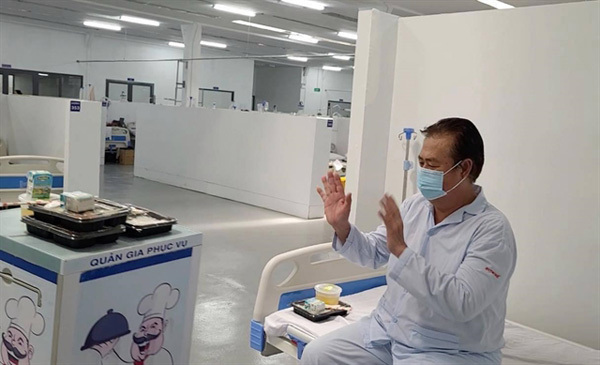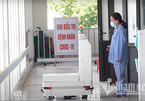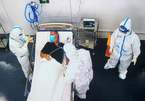 |
| Ta Van Loi, a COVID-19 patient at the COVID-19 resuscitation hospital in HCM City, receives his meal from the robot. Photo courtesy of the hospital |
Ta Van Loi, 62, from HCM City was treated for 10 days at the Intensive Care Centre of the hospital and then transferred to an area for patients who were recovering. While in the ICU, he was both treated and fed by doctors and nurses, while at the new site, he was served by a very special member of staff.
Around lunch time, a cube-shape robot approached his bed with a lunchbox on top. In the box, he found ribs and potatoes, soup, rice and a carton of milk.
“We call it our “butler”, who does not wear protective gear but is not afraid of the SARS-CoV-2 virus,” Loi said.
“The meals brought to me are also hot and delicious,” he said while the robot continued its journey to other patients’ beds.
Ho Thi Ngoc, another patient from Tan Phu District, HCM City, was also served the same dish. When the robot approached her, she looked at it with curiosity.
“I’m getting much better. When I am discharged, I will really miss these days and our “butler” who delivers meals and medication to me every day,” Ngoc said.
The "extended arm" of medical staff
Doctor Huynh Phuc Minh, head of the administrative and operation unit at the hospital, is the one who built the robots to transport food and medicine to the wards inside the isolation area.
Minh said that during the period that Hue Central Hospital staff came to support HCM City, the hospital had transported three such robots from Hue to HCM City.
"In the days when doctors and nurses work two and three times more than their normal shift, the robot is the "extended arm" of the doctors and nurses at the hospital," Minh said.
The robot is made from two main parts, a children's toy car with a control chip and a compact four-compartment container to store medicine, food and water.
The robot is controlled remotely via a tablet with an Internet-connected camera screen. To "wake up" each patient, when arriving at the area to deliver food and medicine, the robot will automatically emit a familiar sound: "I’m here to serve you, please open the door".
Minh said the operator can follow the robots’ journey to the patients’ beds from the connected camera.
Since the robots were put into use in the ward, there has been a great reduction in the pressure of doctors not only in workload but also in the risk of infection.
"When the COVID-19 pandemic is eased, we will continue to research and manufacture more robots with many improvements in both design and function to meet the needs of COVID-19 patients," Minh said.
Previously, in April, scientists at the Military Technical Academy (Ministry of National Defense) successfully researched and manufactured a medical assistance robot system with modern features based on TUG robot model of Aethon (USA).
VIBOT robots can work in groups in the isolated area to replace and support medical staff in serving and taking care of COVID-19 patients and suspected infected people.
VIBOT also has the ability to transport garbage bins to rooms to collect garbage and transport them to the rubbish dump, and move to patient rooms to enable doctors and family members (outside the isolated area) to have remote communication with patients.
According to the robot developers, the robot was updated in phase 2 (VIBOT-2).
VIBOT-2 is designed with more intelligent features such as the ability to self-build maps, self-locate and set operating routes, and safely move in and out of designated areas to perform tasks without assistance.
After one year of implementation, the VIBOT-2 transport medical robot system was installed and tested at the Hanoi-based 108 Military Hospital.
Since late April, the VIBOT-2 system has been used at the isolation and treatment area for COVID-19 patients of Bach Mai Hospital in Phu Ly City, Ha Nam Province, serving over 150 COVID-19 patients.
After that, the robots were used during the third pandemic outbreak in the northern province of Bac Giang in May. In early August, the robots were working at the field hospital No. 7 in Thu Duc, HCM City.
Source: Vietnam News

'Make in Vietnam' robot delivers food and supplies to Covid-19 patients
VIBOT medical robots are playing an important role in transporting food, supplies for Covid-19 patients, and medical supplies from outside to isolation areas.

Robots used to treat severe Covid-19 cases in HCM City
The robots talk to Covid-19 patients and send information about the situation to medical experts. They can also transport food, drinks, and medical materials to patients' rooms.